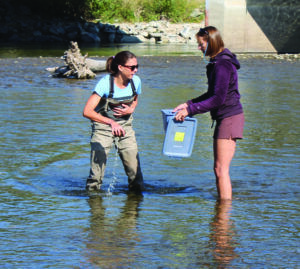
DEQ releases draft Bitterroot River Nutrient Protection Plan
The Department of Environmental Quality (DEQ) has released a draft Bitterroot River Nutrient Protection Plan which indicates the river is not impaired. The Nutrient Protection Plan is a non-regulatory document, according to Hannah Riedl, a water quality specialist in DEQ’s Nonpoint Source Program. She said it is meant to provide guidance and recommendations in meeting Montana’s constitutional mandate that “the state and each person shall maintain and improve a clean and healthy environment.” She emphasized the word ‘maintain’.
In 2019, DEQ adopted a 20-year plan to do long term water quality monitoring on the mainstem of the Bitterroot River from the confluence of the East and West Forks to where it joins the Clark Fork River in Missoula. At the same time, the agency adopted a new funding procedure called the “Focus Watershed” approach in which the agency concentrates nonpoint source funding and technical aid in a specific watershed for up to three years. This targeted approach maximizes the cumulative impact of water quality restoration projects within a watershed. The Bitterroot was named the Focus Watershed recipient in 2019 and has benefited from the focused funding and aid over the last three years.
According to John DeArment, the lead scientist for the Clark Fork Coalition who is supervising the Bitterroot River monitoring as part of the overall monitoring being conducted in the Clark Fork Basin, the condition of the Bitterroot River in terms of nutrients is looking pretty good. It’s too early to make any confident statements about trends, but the current condition is well below the levels that would indicate serious impairment.
“The Bitterroot River is not currently impaired by nutrients, making it unique in Montana for a river of its size in a rapidly developing watershed,” said Reidl. She plans to keep it that way and that’s what the Nutrient Protection Plan is all about.

The document describes sources of nutrients, presents population growth scenarios and provides recommendations for preventing nutrient impairment. Human activities can result in excess nutrients that pose a threat to human health and the environment, including through proliferation of nuisance or toxic algal growth. Nonpoint sources of nitrogen pollution are the primary threat to maintaining the Bitterroot River’s high-quality nutrient condition, according to DEQ. Nonpoint sources of pollution include, but are not limited to, road and streambank erosion, fertilizers from croplands and lawns, and human and animal waste.
“The growing population of the Bitterroot Valley poses challenges for maintaining water quality,” said Riedl. “This document can be used as a roadmap for individuals and communities looking to manage development pressures while protecting this valuable resource. Keeping the Bitterroot River unimpaired may help prevent loss of revenue for the recreation industry, maintain property values, and avoid extra expenses for agricultural operations, water treatment and restoration efforts.”
The Nutrient Protection Plan recommends voluntary best management practices for reducing nutrient pollution. Restoring and protecting native streamside vegetation is an example of a best practice that protects the Bitterroot from pollution. Another important example is managing existing and new septic systems. The Plan recommends that existing homes and new construction hook into municipal systems where possible. Alternatively, new subdivisions can incorporate a centralized treatment facility, or individual homes can install Level II or higher treatment systems.
The draft Bitterroot River Nutrient Protection Plan is available for public comment until March 28, 2022. A final draft is expected by the end of the year.
Comments on the draft version may be submitted electronically or by mail. DEQ will present the draft Bitterroot River Nutrient Protection Plan as part of the upcoming Bitterroot Focus Watershed Stakeholders Meeting. The public is invited to attend to hear the presentation. To view the document, view a short presentation on the plan, submit comment or to access the meeting online, visit: https://deq.mt.gov/News/publiccomment-folder/news-article60
